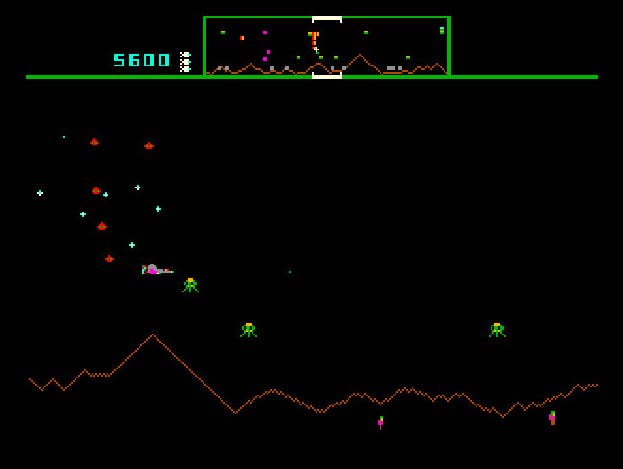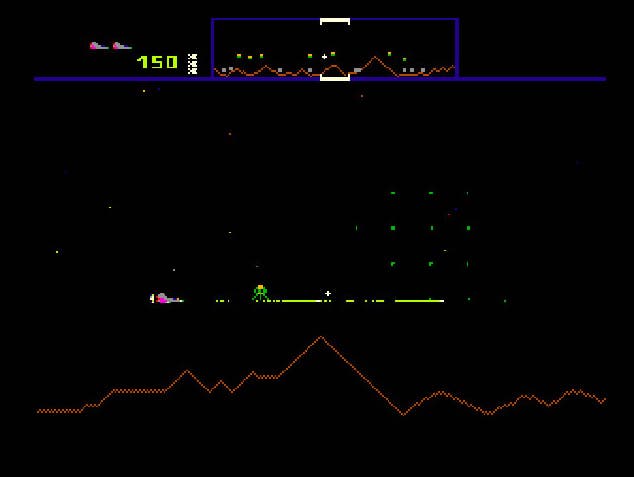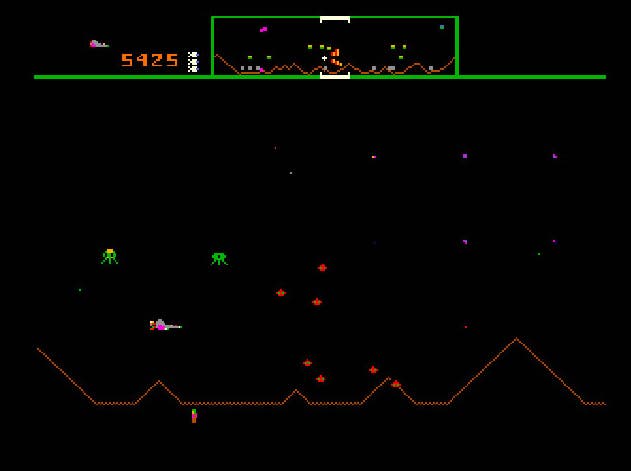Defender
Defending the indefensible.
In the crazy unreality that games reviewers generally live in, one minute you're up to your ankles, wading through beautiful rippling water, gazing up at a vast, beautiful stone architecture reaching up into the sky, the next you're recoiling in horror as a roaring chainsaw cleaves your skull in one fluid, sickening motion. The next minute, the miracle of electricity ensure that you live to fight another day - this time asking your frazzled synapses to journey back in time to 1980 to pilot a space craft in a last ditch attempt to save mankind from a determined alien invasion. To the sounds of Baggy Trousers.
In late November 2006 (to the sounds of, I dunno, Wolfmother), some of the very same people that will be busy drowning in their own blood in Gears of War will flick back to the 360 dashboard, decide to fire up Defender and try and convince themselves that it really was better the way things used to be when The Beano cost 6p and your phone number had four digits. Oddly enough, both games were released on Microsoft's system within two days of one another, and the technical contrast between the two could hardly be more difficult to comprehend. From little pixels do mighty digital entertainment industries grow.

And you, young whipper-snapper at the back, you can wipe that smirk off your pre-pubescent, blackhead-ridden face. Defender was one of the biggest grossing arcade videogames in coin-op history, netting a cool $1 billion for Williams during the famous golden era of arcade gaming when people actually had to leave their house and mix it with under-age smokers in order to play cutting edge games. Is my soul purer than yours? I'll let God figure that one out...
Lazy days
Nowadays (I've never been convinced that's a real word, but hey), the average workshy home-based Internet journo fop can go through an entire day without leaving the house, proving again that mother was right that playing videogames would get me nowhere. Literally. Home deliveries from Sainsbury's for the bloody win, Play.com and CDWow for those all important low-priced entertainment purchases, and Xbox Live Arcade for nostalgic, frivolous, pocket-money priced retro thrills. How sad, lonely and pointless is my life sounding? Very? Good. Then onwards with the review.
If you've never had the good fortune to play the original Defender arcade machine, then, as a gamer you haven't really experienced the true definition of pain. We're talking thumbscrews pain. Mount Everest pain. The pain of instant death. Of psychic pixels homing in at superhuman velocities on your roaring spacecraft and destroying it in one hit before you can possibly react. Of Game Over screens in under three minutes. That's, as Paul Weller wrote at the time of Defender's release (possibly related), Entertainment. Devised around a control system that even insiders at Williams thought was 'ridiculously hard', it somehow managed to seduce a game hungry audience into throwing a ridiculous amount of money into the machine in the misguided belief that they could eventually tame its inner workings.
Some obsessed, superhuman individuals with more hair than can be healthy managed it. Most of us, of course, never had the sort of money (or the hair) required to get good at it and quickly moved onto more forgiving, cuter looking games like Pac-Man, Mr Do and Donkey Kong. Jeff Minter was good at it, but then, thinking about it, he also had the hair. Unsurprisingly, he did a remake for the Atari Jaguar in 1995 and probably played this on Xbox Live Arcade last night. Anyone know his gamertag so we can check?

Control freak
Anyway, yes. The control system. It was designed around more buttons than your average Street Fighter II cabinet, and most people found it to be utterly unforgiving. Well, most people who were a bit rubbish like me. The real hardcore loons that actually preferred being tied up in dexterous knots will take one look at this largely spot-on conversion and spit bile and venom (in that order) that the Xbox 360 pad could never accurately replicate what it was like to control. But let's agree to disagree and admit that few old arcade ports lend themselves to the limitations of the otherwise pretty excellent 360 pad. If you're not some bitter old man with hang-ups, Defender works as well on the 360 as you could reasonably expect.
Of course, like all of Digital Eclipse's ports so far for Midway (the rights holders and publisher), the graphics have been pointlessly 'enhanced', but in a manner which is reasonably subtle and unlikely to send retrophiles into a frothing rage too much. It's easy enough to switch off, though, and in no time you can get to grips with saving little men from getting abducted by the Lander aliens that teleport (cunning) into the level and swoop down mercilessly. The idea is to fly from left to right (or vice versa, of course) around the wraparound scrolling landscape and attempt to wipe out the alien threat as quickly as you can. If you dilly-dally too long, the Landers will capture the humans and turn into annoying Mutants that buzz around and spit bullets around at a faster rate and become harder to hit. And if you're really tardy, you'll eventually encounter the supremely fast Baiters that can fly faster than you and hit you with unerring accuracy.
Progress onto the subsequent stages introduces the evil Bombers, Pods and Swarmers, which, to be frank make life incredibly difficult for the average player very quickly. Armed with only three lives (plus a bonus after 10000 points) and three smart bombs, the odds of you surviving beyond round two are pretty minimal unless you have supreme reserves of patience and skill. It's by no means impossible, but stacked up next to practically any game on Xbox Live Arcade, Defender is by some distance the most challenging.
Friends reunited
Xbox Live Arcade introduces the very welcome co-op challenge, which ought to be of major interest to the real hardcore players schooled in early '80s gaming lore, but - as with so many Live Arcade games, finding casual gamers waiting to play you online is relatively unlikely. Hook up with a mate, though, and you're away, and you can unlock a few achievement points for your pains as well.

The rest of the achievement points are relatively tough nuts to crack - particularly the one that tasks you with not firing a bullet, a smart bomb or teleporting for 75 full seconds. I tried this relentlessly for over two hours, and nearly managed it about 5 times, only to get nailed by the dreaded Baiter at about 73 seconds. Seriously, once the planet explodes and you've got the entire mutant invasion tailing you, a second or two feels like a lifetime.
But aside from such frivolities, there's no major compulsion to keep playing unless you've got some score grudge thing going on with some mates. On its own, the game simply feels a little too old school for my liking, with so many punishing characteristics that it stops being a fun curiosity quite quickly, and more like an example of how routinely punishing exercises games were back in those innocent days.
If you're a long-term fan and haven't already bought it on one of innumerable compilations out there, then 400 points is just about tolerable for a game of this importance and stature - just be aware that unless you have some sort of emotional attachment to it that it'll feel like you've just bought some kind of gaming endurance test, rather than a piece of actual entertainment. After that, you can get back to chainsawing people in half and do the whole time travel thing in reverse.








